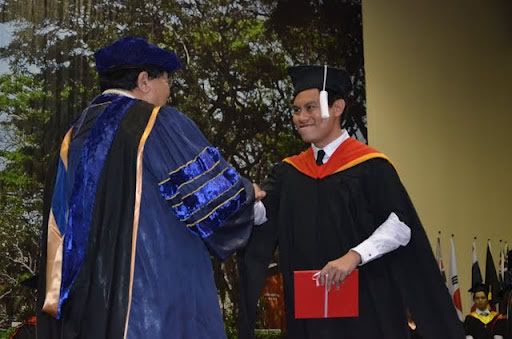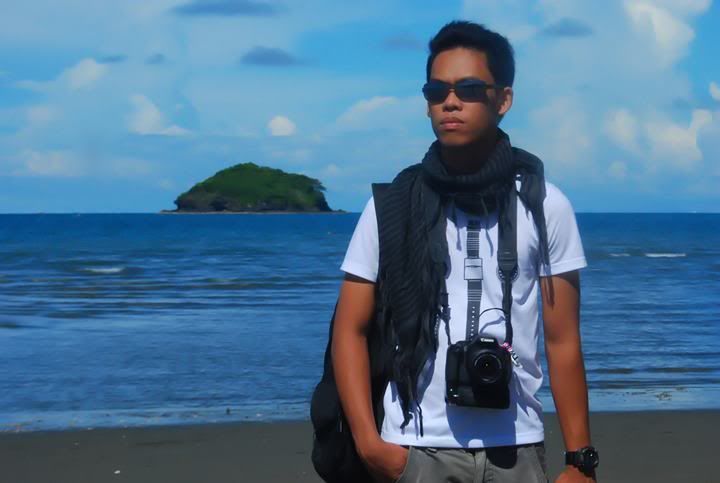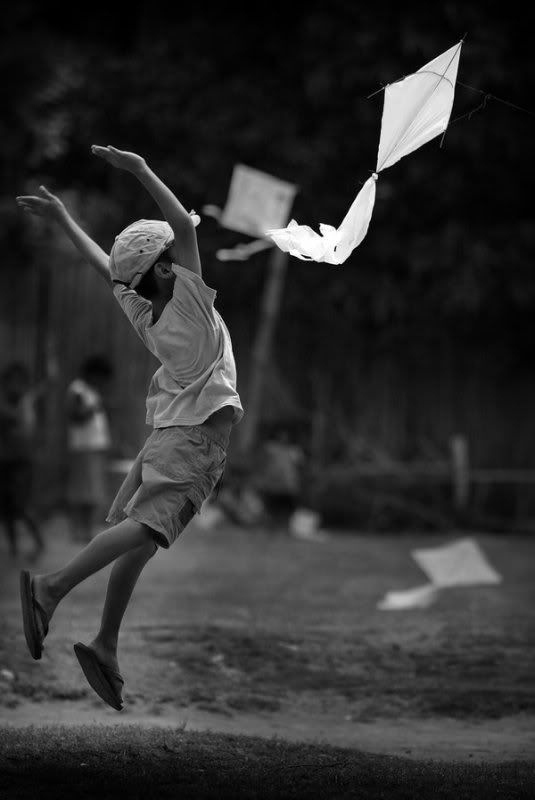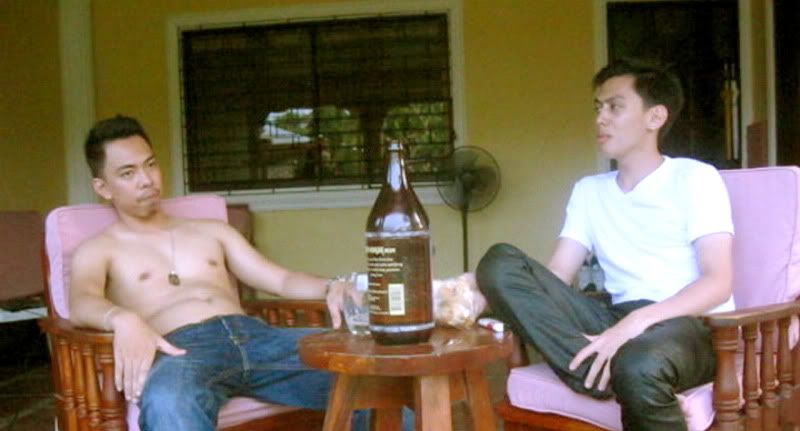Friday, March 30, 2012
 9:27 PM |
The Staycation Option
9:27 PM |
The Staycation Option
For the past few months, ever since I started work on my graduate thesis, I've developed this (highly expensive) habit of just leaving the too-comfortable confines of my apartment -- and checking into the AC-comforts of a hotel room. With a good bed. And good wifi. With the TV remote untouched, hotel rooms are great havens for people who need to finish things in relative comfort, without the distractions of home.
I've been frequenting this one new hotel right in the middle of downtown, which is rather cheap and comfortable -- save for the horrendous plastic flowers as decor, and the linoleum tiling in the bathroom that ultimately turns the entire showering adventure into something quite icky. (Bring slippers!) The hotel will, of course, remain unnamed.
But here is this new find. GoHotel just opened a branch in Dumaguete, and offered me a much welcome complimentary accommodations this weekend as it goes through its dry-run/soft opening. The rates, while not fixed (
they have this Internet promo thing as a system), are quite remarkable considering the compact and inspired execution of the rooms, which, while tiny, are more than good enough for a traveling nomad, or a person bent on a staycation. Like I am. (I like what they say in their website: "We want you to sleep like royalty, but we won't ask you to fork over a king's ransom. Thanks to the year-round low rates, every Juan, Dick and Larry can afford hotel-quality sleeping experience.")
I love staycations. Staycations give me the thrill and the illusion of "travel" without me having to leave the city I am bound in because of work and other responsibilities. Staycations are cheap. They are relaxing. They give one a sense of the different that never fails to jog the imagination.
So here we are, on a Friday night, behind Robinson's Place in Dumaguete, checking into this bright spot...



This is the entrance to the hotel...

These are the wonderful members of the staff, Angelo and Reicha....

This is the corridor of the first floor. (The second floor is still being finished as I type.)

This is my room...

This is me inspecting the new (temporary) digs...

This is the bed, and now home of my gadgets...

This is the mandatory bathroom shot...

And this is me easing into the night, about to start writing/editing my novel, trying to find the courage to turn off the television...
So wish me luck, and may you have a great weekend ahead.
Labels: dumaguete, holidays, hotels, life, travel
[2] This is Where You Bite the Sandwich

 4:36 PM |
Finishing Things
4:36 PM |
Finishing Things

Truth be told, it took me forever -- about eleven years -- to obtain my MA degree. Somewhere along the way, I lost direction. First, my Graduate School teachers moved to other universities, some to other countries. Then work, and more work, happened. Then love happened. Life happened. So many excuses. And then after a while, finishing my degree didn't seem to matter anymore. But something (in fact, many things) happened to me in between 2008 and 2009 that put things in perspective, and made me realize what I considered truly important in this life. I've written considerably about my Christ Year and its aftermath, which culminated on that lovely quiet spot on top of a hill in Sagada.

That Sagada experience has finally translated to this: a diploma. And a degree.
Of course, these things are never done, or finished, without other people to lean on to for support and encouragement. The writing of a master’s thesis is almost always fraught with drama and self-doubt, and these are the ones who made the unbearable bearable.
In my moments of utter chaos, there was one kind of stillness that I counted on time and again—God in His infinite graciousness and kindness. Sometimes I call Him the Universe, which is one and the same thing. He guided me through the hard times, and answered my prayers with such generosity, teaching me always to trust in His plans.
In my acknowledgment, I thanked a thousand people for getting me through the tough work. But I would like to specifically thank in this blog the following people for their help and guidance (as well as the much-needed tough love) in finishing this thesis: Dr. Ceres Pioquinto, Dr. Ben S. Malayang III, Dr. Margaret Helen Udarbe-Alvarez, Dr. Betty Cernol-McCann, Dr. Betsy Joy Bustamante-Tan, Dr. Laurie Raymundo, Dr. Elizabeth Susan Vista-Suarez, Dr. Gladys Rio-Malayang, Prof. Leonor Briones, and Prof. Gina Fontejon-Bonior. Quite a formidable bunch to compose my own pressure cooker. But these were the people who persevered with me for close to a decade, giving me just the right amount of encouragement to get me going, especially through the tough times when I was ready to give up. My panel has been most helpful in giving shape—and giving encouraging insights—to this thesis: my adviser Dr. César Ruìz Aquino (from whom I’ve learned much about the magic of creative writing), Prof. Philip Van Peel, Dr. Evelyn Mascuñana, Dr. Maria Teresita Sy-Sinda, and Dr. Andrea Gomez-Soluta in whose literary research class actually was planted the seeds of this thesis. I would like to thank my other professors in Graduate School—Prof. Timothy Montes (who got me started on creative writing), Prof. Eva Rose Repollo-Washburn, and Prof. Antonino de Veyra—for the guidance.
In particular, I would like to thank the great poet and critic J. Neil C. Garcia, whose many ideas on Philippine-specific queer theorizing fill this thesis.
I would like to thank Ron Jacob Calumpang for egging me on constantly, and for being the constant presence that anchored my often wandering mind.And finally, I would like to thank [Dev] who absolutely has no idea how much he has influenced the completion of this thesis. Thank you.
Labels: life, school
[1] This is Where You Bite the Sandwich

 1:38 AM |
The Photographer of Moments
1:38 AM |
The Photographer of Moments
Part 1 of the Dumaguete Design Upstarts SeriesWhat inspires, or propels, someone to pursue art? Every artist has his reason, and there is no one answer to this question of beginnings. What we can know for sure—even if only in the language of the ephemeral—is the gravity that great art bears on us upon encounter. Sometimes great talent is something we come by through sheer accident, and sometimes we are drawn to it by the power of word-of-mouth. Regardless of how one comes about it, the sheer impact of its recognition is powerful. One is simply reduced into a state of awe. It is almost always a religious experience, as if having come in touch with it, you get an inkling of the spiritual.
It felt exactly that way when I first beheld one of my favorite paintings, Edward Hopper’s 1942 painting
Nighthawks—a somber existential drama in bright lights and color depicting four denizens in a city trapped in nighttime, in a bar, seen through a windowpane. Something about this painting has always intrigued me, deepening all the more over the years. When I finally came to see it for real in the gracious halls of Chicago’s Art Institute, I stood before it like a muted acolyte. I stared at it for what seemed like forever, unable to believe that I was finally seeing this great masterpiece, that it was before me. The experience of it moved me, and I must confess to tearing up just a bit, a wistfulness that was quite unexpected. Great art moves you like that.
One time, I was in a gig in Café Antonio when they used to do musical revues once every few weeks. (I don’t know why they don’t do that anymore.) I’m not sure exactly now what show that was. Perhaps it was the Apo Hiking Society tribute show, but I remember most this after-show jamming where this one singer—whose name escapes me, regrettably—started singing “Quando, Quando, Quando.” The guy did it with such unbelievable grace, his voice touched by something of a svelte naughtiness—I think everyone of us in that room stopped whatever it was we were doing, and just paid the greatest tribute of all: we listened, and we tried to capture the nuance of every single note. And when his song ended, we looked around, and we smiled. And somehow we knew we were touched by the divine in that masterful rendition of an old song.
Of course, these things come by rarely. The world, alas, is mostly awash in mediocrity. The shallow is currency in a world that is besotted by the common. The sublime always gets the shaft in favor of the silly. It is a world ruled by plastic beauty, the Kardashians, Taylor Swift, and
Twilight. Which is why, when we see great talent—especially in the small corners of Dumaguete City—we pounce on it like the treasure that it is.
This is an attempt to chronicle, somehow, a glimpse of what the future holds for the artist in Dumaguete, in particular the young people in this city who are into design. Because much has been said, and written, about our visual artists, our budding filmmakers, our writers—but what about those who dabble in photography, in fashion and jewelry design, in graphic design, in architecture, in interior design, in video art, in furniture design, in mixed media? Design is a tricky business of aesthetics, defined once by Valerie Pettis as “the search for a magical balance between business and art; art and craft; intuition and reason; concept and detail; playfulness and formality; client and designer; designer and printer; and printer and public.”
This brief survey of great young designers and artists in Dumaguete is not meant to compose an exhaustive list. God knows I must have missed one of two (or more) deserving of space in this essay. But these are the people who—over the past few years—have struck me as having captured something of an acute understanding of design. And they are young, of course—in body, and in ideas: composing a bright future for a city that will soon be in reckoning of their talents.

One begins with Hersley-Ven Casero, of course. Only a few weeks ago, he sold—through auction, which was a first in Dumaguete—a painting in benefit of the victims of Sendong and the Guihulngan earthquake. He is hardly an up-and-comer, having come into his own the past few years with his photography, and now his paintings. He got his start in design work in 2004 when he held his first digital camera, issued to him by Foundation University, where he now works. That encounter with the camera brought a bewildering enthusiasm in him: “I always brought it with me, and I took pictures of
everything,” he admitted.
Later on, Hersley realized that his interests lied primarily in portraits, especially in capturing how his subjects interacted with their environment. That bent is something he has come to nurture more and more. “It is photojournalism and documentary photography that I want to venture more into,” he said. “For me, this kind of photography is like catching the moment beyond the normal, and with spontaneity and decisiveness.”
And then he met photographer Luis Sinco of the Los Angeles
Times. The encounter proved productive, and this spurred him on with his interests. “There would be no Hersley-Ven Casero if there was no Luis Sinco,” he said. “He taught me a lot of things about photography—from the knowledge of the basics, up to the most complicated techniques. But he also taught me not just about recording images. He also taught how to interpret them, and how to deliver the message or the story behind a particular photo.”
Besides Mr. Sinco, he also cites Henri Cartier-Bresson as a major influence: “I admire his works because of the ‘joy of geometry’ that you see in his photographs.” He also cites Eugene Smith, an inspiration of a more practical sort: “Even when [Smith] had difficulties in his career, he still pursued and continued doing it.
But what is the underlying philosophy behind Hersley’s work? Looking at his photographs, and hearing him talking about them, it comes to me that it is not so much a philosophy than a form of intent. “It gives me satisfaction to share a slice of reality with every person seeing my photographs,” he says. “I put my heart in every picture I take, and for me that is one way of creating work that is edgier than expected.”

In that, Hersley makes a claim that his pictures speak really about his love for life. “I see life in a different way,” he said, “as a beautiful gift that one should treasure because it is worth keeping. I consider myself as the keeper and preserver of those precious moments that is part of life.” He cites his photo titled “Lift Up Yourself” as an example of this philosophy. It is a black and white photo of a kid at play with his kite. There is a sense of joy to the picture, and a sense of dramatic involvement demanded of the viewer. And the picture very much seems to capture an elusive moment of happiness in a child’s life. “Many of my friends thought this was a manufactured photo, a posed shot,” Hersley said. “In fact, this is a very good example of my philosophy of just catching a moment.”
(Next: Photographer Kat Banay as the Capturer of Natural Light….)Labels: art and culture, design, dumaguete, photography
[0] This is Where You Bite the Sandwich

Saturday, March 17, 2012
 6:14 PM |
New Cinematic Voices From Dumaguete
6:14 PM |
New Cinematic Voices From Dumaguete
First off, I must extend my congratulations to the winners and participating filmmakers of the
Third 61 Student Short Film Festival in Silliman University! It was an unexpectedly tremendous, jam-packed success—and now there plans afoot to make it bigger, perhaps even to expand the pool of talents beyond the College of Mass Communication.
Three years ago, when I was invited to be the Dumaguete representative for that year’s edition of the Film Congress of the Cinemalaya Independent Film Festival, I was asked during my panel at the Cultural Center of the Philippines whether there was a sizable filmmaking community here. And yet, despite my presentation declaring the city to be a cocoon for such filmmakers as National Artist for Film Eddie Romero, Seymour Barros Sanchez, Jonah Lim, Carmen del Prado, Ramon del Prado, and myself, there was not much you could consider to constitute a “community”—meaning there was no active active filmmaking scene, even of the independent variety, that churned out a regional cinema.
Later that year, in my film class for what was then the School of Commmunication, I challenged a group of students to make their own short films, and those who rose to the challenge—among them Anthony Gerard Odtohan (with
Papa Mike and the Rainbow Village), Eliora Bernedo (with
The Bird, The Bees, and All the In-Betweens), Karen Grace Yasi (with
The Anniversary), and Marc Cabreros (with
The Web Cam)—produced short films of a beginner’s variety: rough, but ultimately showing a promise of bigger and better things. That edition of what is now known as the 61 Short Film Festival showed us that things can happen, if we let them happen, of course with the attendant “pushing” that comes with any project. It showed us that Dumaguete was perfectly capable of creating its own regional cinema. Bacolod, across the island in Negros Occidental, was already leading the way. Dumaguete
Soon, we saw the trickling of filmmaking turning into a kind of flood. In 2011, SPI Global—a call center company in Dumaguete—ran a short film contest that yielded a filmmaker in Mark Duran. Also that year, North City Elementary School and the Negros Oriental State University also ran short film competitions that may have produced films short on either technological or story-telling considerations, but signaled more than just cinematic possibilities: they showed that Dumaguetenos—given the chance—were perfectly capable of becoming filmmakers. They have stories to tell, and they knew how to tell it in the specialized language of film. Soon, we got Stephen Abanto’s
Suga, an animated horror film; Razceljan Salvarita’s
I Am Patience, a nature film that is a meditation of Zen-like stillness; and Hersley-Ven Casero’s
Paper, a kind of animation that utilized more than a thousand still pictures to create the story of a piece of paper as it journeys around the Foundation University campus.
Suga and
Paper became the city’s representatives to the 2012 CinemaRehiyon Festival in Bacolod City. The year before that, the city was represented by Carmen del Prado’s documentary
Dumaguete—An Artists’ Haven.
This year’s festival crop is an amazing group that includes Jose Adrian Miraflor’s
Voldemort Must Die, which won Best Film and Best Director for Miraflor. The film also won the Audience Choice Award, Best Supporting Actor for Von Colina, Best Supporting Actress for Abbie Sagucio—and then Best Editing, Best Sound, and Best Costume Design, all for Miraflor. Mahogany Rae Bacon’s
Marry Me won the Jury Prize for Best Film, and also won Best Actress for Megan Alexandra Cariaso, Best Cinematography for Aris Ramiro, Cezar Galang, and Jerick Hernani, and Best Make-up for Nicole Villanueva. David Delantar won Best Actor for Crizza Almagro’s
Submarino.
Best Screenplay went to Mariella Sagarbarria Bustamante and Shadid Sidri for
Temperomine, which also won Best Production Design. Best Musical Score went to Jem Robert Talaroc for Kaiza Abaincia’s
Mikaela. Best Poster Design went to Eunji Ha's
The Haunted House.
Congratulations to the other student filmmakers Precious Grace Heradura (
Party), Beverly Linao (
Document1), and Grace Yang (
Crossed Destiny) for a job more than well done. And thanks to our Jury composed of Ma. Cecilia Genove, Dessa Quesada-Palm, Annabelle Lee-Adriano, Greg Morales, Ian Manuel Mercado, Carmen del Prado, Hersley-Ven Casero, and Hope Tinambacan.
Let’s hope for even bigger things, cinematically-speaking, in the nearest future.
Labels: art and culture, cultural affairs committee, dumaguete, film, silliman
[0] This is Where You Bite the Sandwich

Saturday, March 10, 2012
 5:22 PM |
Stills From New Voices
5:22 PM |
Stills From New Voices
Continuing the project of creating a sizable community of filmmakers in Dumaguete, we launched the third edition of the 61 Student Short Film Festival last night. The response was electric. The community may be young, but it's dynamic, and it's a very good start...

From Kaiza Abaincia's
Mikaela. This won Best Score for Jem Robert Talaroc.

From Crizza Almagro's
Submarino. This won Best Actor for David Delantar.

From Mahogany Rae Bacon's
Marry Me. This won the Jury Prize for Best Film. This also won Best Actress for Megan Alexandra Cariaso, Best Cinematography for Aris Ramiro, Cezar Galang, and Jerick Hernani, and Best Make-up for Nicole Villanueva.

From Mariella Sagarbarria Bustamante's
Temperomine. This won Best Screenplay and Best Production Design for Bustamante and Shadid Sidri.

From Eunji Ha's
The Haunted House. This won Best Poster Design for Eunji Ha.

From Precious Grace Heradura's
Party.

From Beverly Linao's
Document1.

From Jose Adrian Miraflor's
Voldemort Must Die. This won Best Film, as well as the Audience Choice Award. It also won Best Director, Best Editing, and Best Costume Design for Miraflor, and Best Supporting Actor for Von Colina, and Best Supporting Actress for Abbie Sagucio.

From Grace Yang's
Crossed Destiny.
Labels: art and culture, cultural affairs committee, dumaguete, film, negros, silliman
[0] This is Where You Bite the Sandwich

Friday, March 02, 2012
 12:32 PM |
Curtains Up, Lights On
12:32 PM |
Curtains Up, Lights On
At curtain call last Thursday night for Eve Ensler’s
A Memory, A Monologue, A Rant, and A Prayer, nobody among the audience at the Claire Isabel McGill Luce Auditorium clapped. Not at first. And then only a timid few—nothing resounding the way one would applaud a circus act.
Yet that relative silence in the house at the end of the show—the tenth year offering by VDay Silliman University, which traditionally stages Ensler’s infinitely lighter
The Vagina Monologues—was not an indictment of its quality. On the contrary. I think it was the fitting reception to a play that was in turns funny and harrowing—but more the latter than anything else. As Silliman President Ben S. Malayang III once put it in the 2008 staging of the same play, “I don’t know whether to clap or not at the end of each monologue. The performances were fantastic, but the issues they presented were brutally frank it felt wrong to hear the sound of applause.”
 Suzanne Lu-Bascara as a Sudanese nun in "They Took All of Us."
Suzanne Lu-Bascara as a Sudanese nun in "They Took All of Us."Indeed, the performances this time around were sterling and precisely observed, distilled to uncanny identifiability and pathos by director Dessa Quesada-Palm who has outdone herself. Consider the stories we get from
MMRP… Lawyer Myrish Cadapan-Antonio plays a woman questioning the sadomasochistic relationship she finds herself having with her husband in “The Perfect Marriage.” Globe marketing head Jacqueline Veloso-Antonio plays a woman remembering a violation she had to endure in childhood during soccer camp in “First Kiss.” Hochi Benitez plays a rape victim detailing, with unflinching thoroughness, her brutalization in “Groceries.” Jessica Delos Santos plays a plucky girl who decides to fight off being gang-raped in “Blueberry Hill.” Francelle Bagaforo plays a Hollywood actress who dreams of roles that go beyond beaten-up (or dead) prostitutes in “I Can’t Wait.” Arlene Delloso-Uypitching essays a plea to breaking our own patterns and cycles of violence in “True.” And Ms. Palm herself plays the allegorical role of an exhausted, unpaid, unacknowledged female workhorse (e.g., the unsung housewife) in “Woman Work.”
And those were the “lighter” monologues. When we get to Naddie May Orillana’s Guatemalan run-away wife trapped dying in a container box on the way “to a better life” in “Celia,” or Earnest Hope Tinambacan’s curiously moving story of an artist who gives his body to suffer in the hands of women who have themselves suffered much in “The Destruction Artist,” or Suzanne Lu-Bascara’s Sudanese nun begging for the lives of her girls kidnapped by a militia in “They Took All of Us,” the tone for the play was complete: this was all unsettling darkness that embraces, but also one that limns hope and light; this was a reckoning and rebuke of a world given to so much violence against women and children…
The play was a necessary purging and eye-opener for many of us in the Luce Auditorium. It is difficult material to stage, but Ms. Palm has done it with its integrity intact. The fact that she has midwifed it to the spectacular form we saw on the Luce stage last March 1 speaks of just how Ms. Palm has contributed to a revival of theater in Negros Oriental.
A revival there definitely is. The past two years have seen a boon for theater in Dumaguete, and
MMRP is only one of the many productions that seemed to have sprouted in town. Even the late director Evelyn Aldecoa herself seemed to have sensed this, giving an inspired revival of
Godspell in December only a few weeks before she passed away.
But we have been talking much too long about the demise of staged drama in Dumaguete. For a long time, we were content only in remembering the glory days when the likes of Ephraim Bejar, Lemuel Torrevillas, Junix Inocian, Paul Palmore, Andy Bais, Laurie Hutchison-Raymundo, Amiel Leonardia, Leoncio Deriada, Jenny Lind Aldecoa-Delorino, Bobby Flores Villasis, among others, had the city in thrall with their prolific outputs. After their generation, there has been relative silence. Of course, once in a while, some student directors—Ana Maria Borja and Claude Ramos among them—would inflame Silliman University with productions of one-act plays and manageable full-length projects, always to have this flame quenched by the fact of graduation.
And yet, I’m beginning to think this is changing. Consider, for example, the explosion of original material being put up: there was the cast-penned musical extravaganza
Kabsi a few months ago, which was followed by its sequel only last January—two trifle pieces of jokes and songs that made up in craziness and fun what it lacked in substance and form; there was the original musical
First Step a year ago, with music by Jai Molina Dollente and Anna Katrina Espino, which first sparked the idea in campus that original work was possible to stage; then there was Nizah Bagares’s
Pepe and Me, a playful contemporary take on Jose Rizal, reimagining him for contemporary youth. As deftly directed by Mr. Tinambacan, it proved to be the most mature among the plays being created now by Silliman students—and it helps perhaps that Mr. Tinambacan has been trained by Ms. Palm in the ubiquitous Youth Advocates Through Theater Arts. YATTA, for the last few years, has been training its young thespians with playwriting work, and the effort has yielded a considerable body of theatrical works with an eye for social advocacy, from waste management to human trafficking. Consider Mr. Tinambacan’s own
We Accept Boarders, staged a few weeks back by Linwell Bongcasan in Silliman Hall. A delightful farce of student dorm life, it may well prove to be the seminal work that will lead the way to a full-blown theater renaissance in Dumaguete.
There are palpable signs of this already. Only last week, the National Committee on Dramatic Arts of the National Commission for Culture and the Arts brought to Dumaguete the sixth edition of the annual
Tanghal, the national university and community-based theater festival. This was in co-sponsorship with Silliman’s Cultural Affairs Committee and YATTA.
It goes without saying that the three-day festival has given local dramatics a significant boost, giving enthusiasts in Dumaguete a glimpse of the possibilities of regional theater. It has also underlined for many of us in Dumaguete a sense that a love for theater can be essential for a love of life.
There is also something about theater that unites the artists among all of us. This is the one art form that—beyond the requisite control of the action, the direction, and the subtle dramas of lighting and sound—also anticipates a consideration for other arts: there’s also music, sometimes there’s dance, there’s literature, and there’s design. To be in theater is to participate in a community of almost kindred spirits—and that is what I have witnessed with
Tanghal 6.
We saw the breadth of the dramatic imagination from almost all corners of the Visayas—from Bohol, the exquisite rendition of history through the pangalay (Antequera and Punta Cruz Cultural Collective’s
Tawag sa Bantayan and
Tamblot); from Iloilo, the possibilities of contemporarizing classic texts for added resonance (University of San Agustin Little Theater’s
Ciento Cincuenta: Mga Bagong Kabanatang Noli at Fili); from Bacolod, the staggering realism of an all-too-common reality heightened to gritty catharsis (University of St. La Salle Maskara Theater Ensemble’s
Room Service), as well as the eye-opening theatrical possibilities of Pinoy hip-hop (College of San Agustin Kanlaon Theater Guild’s
Circulo); from Dumaguete, the lofty reach of representational theater for social awareness—complete with music and the laughter (YATTA’s
Kaluwasan sa Damgo ni Greta and Artista Sillimaniana’s
Ang Tiririt ng Ibong Adarna). Theater practitioners Jojie Benitez, Glenn Sevilla Mas, Rudy Reveche, and Gardy Labad also gave workshops and shared their expertise of decades to a new generation of theater makers—which is what we most need right now: a continual act of inheritance and passing on.
For three days, what we saw was a full engagement into an art that is all-consuming, but for the better. What we saw was enough for us to know that theater is alive and well and has stronger significance in our society: it magnifies for us, after all, in more dramatic ways, how we are as human beings, and as Filipinos.
[photo by Joop Miranda]
Labels: art and culture, cultural affairs committee, dumaguete, negros, philippine literature, silliman, theater
[0] This is Where You Bite the Sandwich

GO TO OLDER POSTS
GO TO NEWER POSTS

















 9:27 PM |
The Staycation Option
9:27 PM |
The Staycation Option










 4:36 PM |
Finishing Things
4:36 PM |
Finishing Things


 1:38 AM |
The Photographer of Moments
1:38 AM |
The Photographer of Moments


 6:14 PM |
New Cinematic Voices From Dumaguete
6:14 PM |
New Cinematic Voices From Dumaguete
 5:22 PM |
Stills From New Voices
5:22 PM |
Stills From New Voices









 12:32 PM |
Curtains Up, Lights On
12:32 PM |
Curtains Up, Lights On
